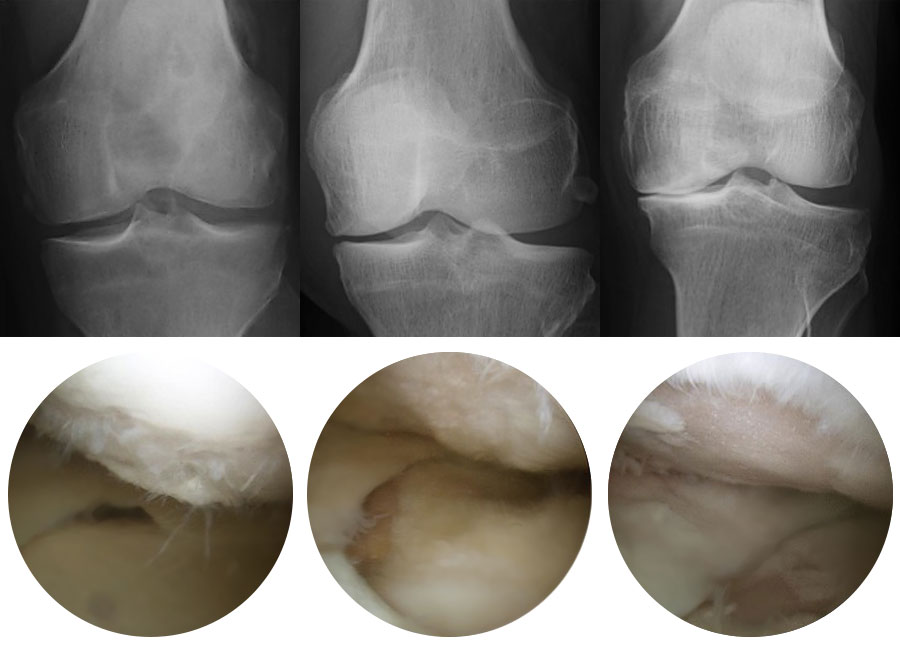Arthritis takes one of two predominant forms
The first is osteoarthritis which is “wear and tear”. This is age related, but can be due to previous injury, trauma, or fracture. It can also run in families. There are a number of other conditions that cause this form of arthritis.
The second form of arthritis is inflammatory arthritis and this occurs in people who have conditions such as rheumatoid arthritis and the wide range of conditions associated with that. People who have psoriatic arthritis, gout and even infection can get an inflammatory arthritis.
What is Arthritis?
Arthritis occurs when there is a progressive loss of the cartilage lining the joint (articular cartilage). On x-ray this is shown as joint space narrowing (that is the space between the femur and tibia (thigh and leg bone) getting smaller. Articular cartilage provides a low friction, load bearing and durable surface, allowing the joint to move without pain, however when articular cartilage is damaged this starts a chain or cascade of events that may lead to arthritis of the joint. Your body tries to repair the joint by forming new bone (osteophytes) so the damaged bone does not have to take as much load as before. However osteophytes do not form where the damaged joint is, and tend to form or grow at the edges of the joints.
Below going from left to right are arthroscopy photographs with matching x-rays demonstrating mild, moderate, and severe (bone-on-bone) arthritis. There is a progressive loss of articular cartilage as you move from left to right.

Osteoarthritis
Not only does the joint lose articular cartilage (joint lining) but there are also other changes in the joint that occur:
- Bony remodeling: The joint tries to repair itself by reforming bone.
- Osteophyte formation: The joint tries to make new bone to off-load the stress placed on the damaged bone.
- Synovial change: The synovium is the lining of the joint and helps to make fluid to lubricate the joint. In osteoarthritis the synovium increases in size to make extra fluid and this will result in your knee swelling, feeling larger, maybe tighter, or warmer.
- Ligamentous insufficiency: Ligaments are important in holding the knee together, helping the knee to move, and to stop it from giving way or collapsing. Depending on the type / degree or severity of arthritis present will depend on whether a ligament is affected or not and to what degree you may have feelings of giving way.
- Muscular change: As your knee becomes arthritic and painful, the muscles will undergo a change, where they will waste (atrophy), or get smaller in size. Sometimes they may also shorten (contract) and you may not be able to get the knee out fully straight.
Symptoms of Arthritis
- Pain
- Swelling
- Decreased Movement
- Crepitus (Bone grating, Bone crunching)
- Locking / Catching Giving way / Giving out
- Gait abnormalities (Limp)
Pain
Nearly everyone with arthritis will get pain. Pain occurs for a number of reasons when someone has arthritis. Pain can be made worse with over-use or repetitive movements, but can also be worse when trying to move initially after a period of inactivity. That is a reason why your knee joint may be sore in the morning when you first get out of bed and you have to sit on the side of the bed or massage around the joint before you get moving. As the joint starts to get moving the pain and the stiffness will generally settle down. As you get out and about doing activities the more you do, the more the joint is likely to be painful. It may even start to swell as well. But it does depend on the type of activity you do and for some people they may notice their joint getting painful only at the end of the day or when sitting down in the evening. People also tend to notice their knee looking more swollen at that time or feeling warmer. Colder weather or climates tend to make people feel the knee is more painful or stiff. I have had a number of patients say that they know when there is going to be a cold front moving in or a cold change starting because their knee starts to get more sore.
Swelling
Swelling results from the membrane lining the knee (synovium) making extra fluid to try and lubricate the joint. In a normal knee there is no need for excess fluid to be made as the articular cartilage is functioning normally and is not damaged. In an arthritic knee where the articular cartilage is damaged and is not functioning normally your knee makes extra fluid to help it move better. Unfortunately this does not happen, but what the patient sees is their knee being more swollen, and feeling warmer. Some people with arthritis will develop a popliteal cyst “Bakers cyst” which occurs in the back of the knee. This cyst exists predominantly in people with arthritis of the knee and the size of the cyst depends on the fluid pressure in the knee.
Decreased Movement
Patients with knee arthritis do lose movement. That is because of what is happening in knee with respect to the degree of arthritis present but also because pain may be inhibiting movement. The muscles around the knee will decrease in size and may contract causing further difficulty in knee movement.
Crepitus (Bone grating / Bone crunching)
Crepitus is actually a relatively common occurrence. Thirty percent of people aged over 30 will have some degree of crepitus. By itself it is nothing to be concerned about, however if it is associated with pain and/or swelling this may represent a problem with the articular cartilage or the underlying bone that is exposed if the cartilage has been lost. At that stage arthritis is likely to be present.
Locking / Catching
Patients with arthritis may present with a locking or catching sensation, in that they cannot get there knee out straight when sitting for a period of time, or from time to time there knee in certain positions catches or feels painful. This in itself may not be the arthritis but could be a meniscus tear (cartilage that sits between the two bones and acts like a shock absorber). If this is the case and it is the predominant symptom then an arthroscopy (key-hole surgery) of the knee may help to settle those symptoms down.
Giving Way / Giving Out
Some patients will experience their knee giving way or giving out. This can be due to pain in your knee causing that to occur or it could be because one or more of the ligaments in your knee is not doing the job they are supposed to do.
Limp
You may notice that you walk with a limp but at other times, your wife, partner, children, friends will tell you that you have a limp. A limp can result from a structural or functional abnormality but can also arise as a response to pain.
Other Factors
- Your walking distance is decreasing
- You are having to use walking aids
You are having increasing problems with activities of daily living:
- Getting dressed
- Showering / Bathing / Toileting
- Making Meals
- Doing chores
- Mowing lawns
- Driving
Leisure activities you can no longer do or are having difficulty with:
- Sports
- Time with grandchildren
- Travel
- Sex
Working is becoming more problematic:
- More days off
- Tasks are more painful
- Performance or efficiency is dropping
Options for Treatment
Knee arthritis can be treated either:
- Without surgery
- With surgery
Each of these will be discussed individually in the treatment section.



